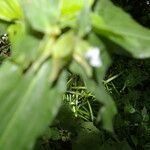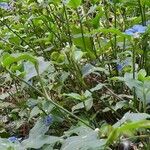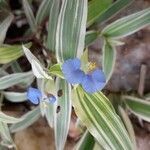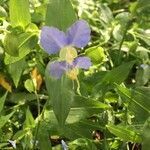Herbs, perennial. Roots fleshy, stout, tufted. Stems cespitose, usually erect to ascending (rarely decumbent, rooting at nodes). Leaves: leaf sheath auriculate at apex; blade sessile or petiolate, linear to lanceolate (rarely lanceolate-ovate), 5--15 ´ 0.3--4 cm, apex acuminate (rarely acute). Inflorescences: distal cyme vestigial, included; spathes solitary or clustered, green, pedunculate, not at all to strongly falcate, 1--2.5(--4) ´ 0.7--1.5(--2.5) cm, margins longly connate, glabrous except along connate edge, apex acute to acuminate, sometimes purple, usually variously pubescent; peduncles 0.5--1(--2) cm. Flowers bisexual and staminate, 1.5--4 cm wide; proximal petal minute, white, distal petals blue (rarely lavender or white); staminodes 3, staminodes and medial stamen entirely yellow; antherodes cruciform. Capsules 3-locular, 2-valved (very rarely 3-valved), 3.5--4.5 ´ 3--5 mm; abaxial locule warty, indehiscent (very rarely smooth and dehiscent); adaxial locules smooth, dehiscent. Seeds 3, brown, with soft, whitish tissue at both ends or in a band, 2.4--3.5 ´ 2.3--2.8 mm, nearly smooth. 2n = 60.
Perennials (chamaephytes), erect or spreading and rooting at nodes; roots hard, when young covered with a velamen of root-hairs. Leaves narrowly ovate-attenuate, 60-120 mm long, pseudo-petiolate at junction of lamina with apex of auriculate, ciliate sheath, margins minutely white-pustulate, glabrous or puberulous. Spathe pedunculate and solitary or clustered apically, fused, broadly ovate-acute, 15-30 mm long, glabrous to puberulous. Lower cyme absent. Flowers with petals blue. Capsule with 3 one-seeded locules; dorsal locule indehiscent, tuberculate, seed fused to wall; ventral locules dehiscent, smooth; seeds globose smooth, farinose.
Perennial herb, 0.2-0.9 m high; stems erect or spreading. Leaves attenuate, 60-120 mm long. Spathe pedunculate and solitary or clustered apically, puberulous. Inflorescence with 1 cyme, lower cyme absent. Flowers: petals blue. Flowering time Aug.-Mar. Fruit a capsule with smooth, dehiscent ventral locule.
Perennial herb, erect or spreading, up to 500 mm tall. Capsule triangular, with dorsal locule indehiscent, tuberculate. Cymes 1 mm each spathe. Leaves narrowly ovate-attenuate, 60-120 mm long. Spathes single and shortly pedicelled. Flowers blue.
A herb. It keeps growing from year to year. The leaves are 4-15 cm long by 1-4 cm wide. The flowers are blue.











